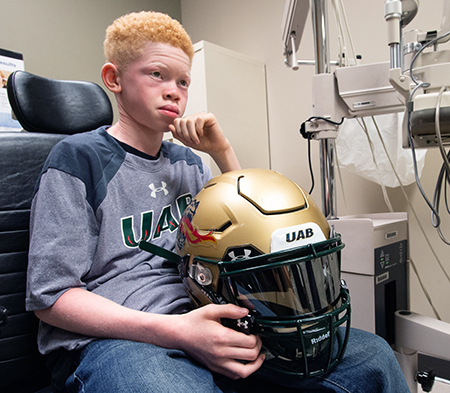 UAB's BlazerVision helped level the playing field for youths like Talyn Lewis, whose extreme sensitivity to light is caused by albinism.Playing outdoor sports posed unique challenges for 11-year-old Talyn Lewis, whose extreme sensitivity to light is caused by albinism, a genetic condition in which a person is born with little to no pigment in their skin, hair and/or eyes.
UAB's BlazerVision helped level the playing field for youths like Talyn Lewis, whose extreme sensitivity to light is caused by albinism.Playing outdoor sports posed unique challenges for 11-year-old Talyn Lewis, whose extreme sensitivity to light is caused by albinism, a genetic condition in which a person is born with little to no pigment in their skin, hair and/or eyes.
“The refs didn’t want me to use a tinted visor even though my pediatrician said I could,” Lewis recalled.
He is not alone. For many adolescents, teens and college-age athletes, visual and other systemic conditions affect their ability to play sports, particularly ones played in direct sunlight. Light-induced migraines and/or seizures, traumatic mydriasis and aniridia are other conditions in which light sensitivity commonly impedes vision and sports performance.
UAB optometrists and ophthalmologists worked with lead medical personnel from UAB Athletics to change the paradigm for Lewis and other vision-challenged children: They helped secure approval for thee athletes to wear a special visor to compensate for light sensitivity and worked to modify restrictions that prohibited tinted visors or other apparatuses. Their work exemplifies UAB’s Shared Values of excellence and achievement, in which we “innovate, solve problems and improve ourselves and others through learning.”
Taking up the challenge
“Many kids who have severe light sensitivity want to be like other kids, and that means many want to be part of a team playing outdoor sports,” said Kathy Weise, O.D., professor in the School of Optometry and director of UAB Eye Care Pediatric Optometry Services. “We knew we could help maximize comfort, safety and access to play for more kids with special conditions.
"When I was asked to consider ideas that might help kids with light sensitivity or light-induced health issues, I immediately thought of my pal Talyn and wanted to help,” Weise said.
 Pediatric optometrist Kathy Weise and team BlazerVision helped convince the Alabama High School Athletic Association to adopt new accommodations for youths with conditions that limit useful vision in daylight or bright lights.Weise helped develop BlazerVision, a partnership among UAB Athletics, the School of Optometry and the Department of Ophthalmology; but, she knew that change needed to start at the high school level. UAB’s eye doctors, lead football team physician and athletic trainer, helped develop a list of specific vison and health conditions that may benefit from a tinted visor and they pitched the idea to the medical director of the Alabama High School Athletic Association. That got the ball got rolling.
Pediatric optometrist Kathy Weise and team BlazerVision helped convince the Alabama High School Athletic Association to adopt new accommodations for youths with conditions that limit useful vision in daylight or bright lights.Weise helped develop BlazerVision, a partnership among UAB Athletics, the School of Optometry and the Department of Ophthalmology; but, she knew that change needed to start at the high school level. UAB’s eye doctors, lead football team physician and athletic trainer, helped develop a list of specific vison and health conditions that may benefit from a tinted visor and they pitched the idea to the medical director of the Alabama High School Athletic Association. That got the ball got rolling.
| "This is a great first step in keeping these eager kids playing sports that they love, just like their peers.” |
“We haven’t seen tinted visors meet regulation standards in sports like football because, although they may seem practical, it may be harder to check the face or the eyes quickly through the visor, or factors like weather may cause the visor to fog up,” Weise said. “So, the tinted visors aren’t for everyone. However, knowing that there are a variety of eye and health conditions that could benefit from having a tinted visor, this is a great first step in keeping these eager kids playing sports that they love, just like their peers.”
Weise and the UAB team of experts presented the idea to the AHSAA, suspecting that Alabama could be the first in the country to offer this type of accommodation for kids. In spring, the AHSAA approved a measure to allow physician-recommended tinted visors to be worn by athletes with “inherited and/or congenital eye conditions that limit useful vision in daylight or bright-light environments.” See a list of those conditions online.
